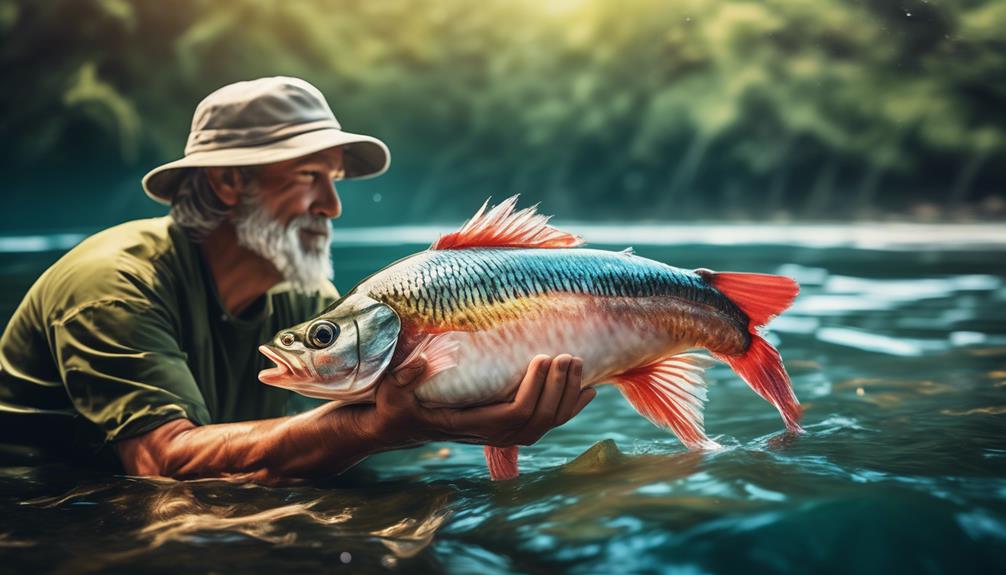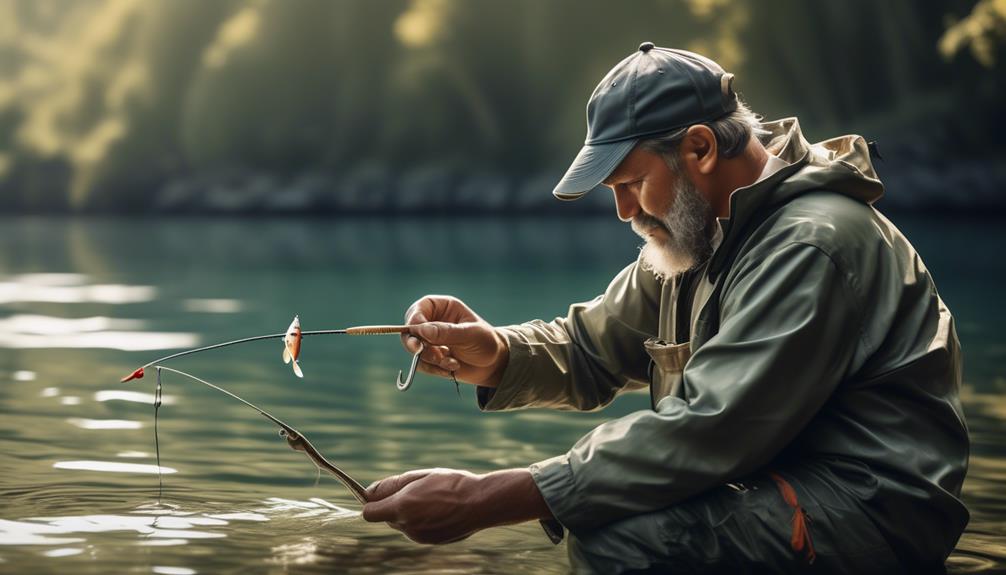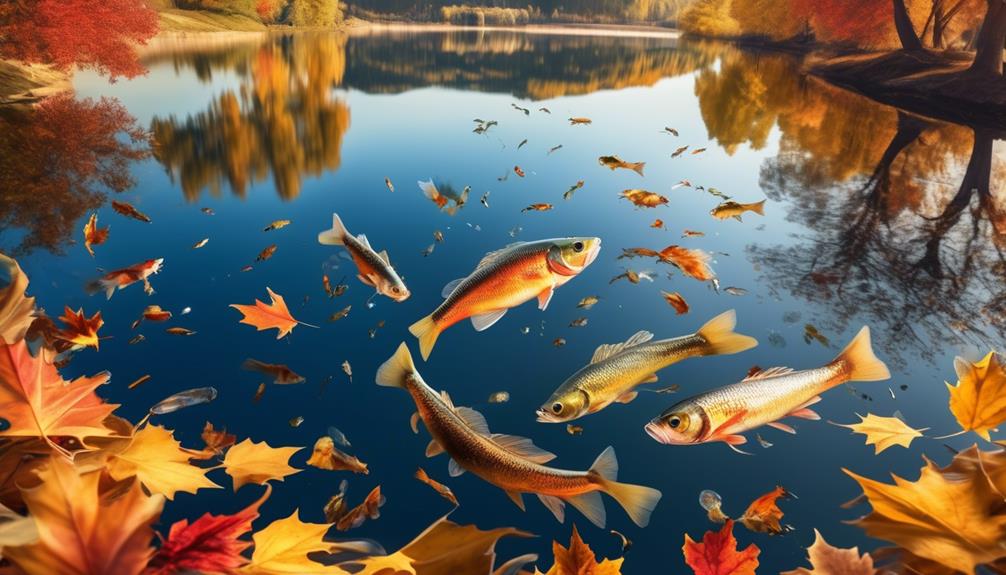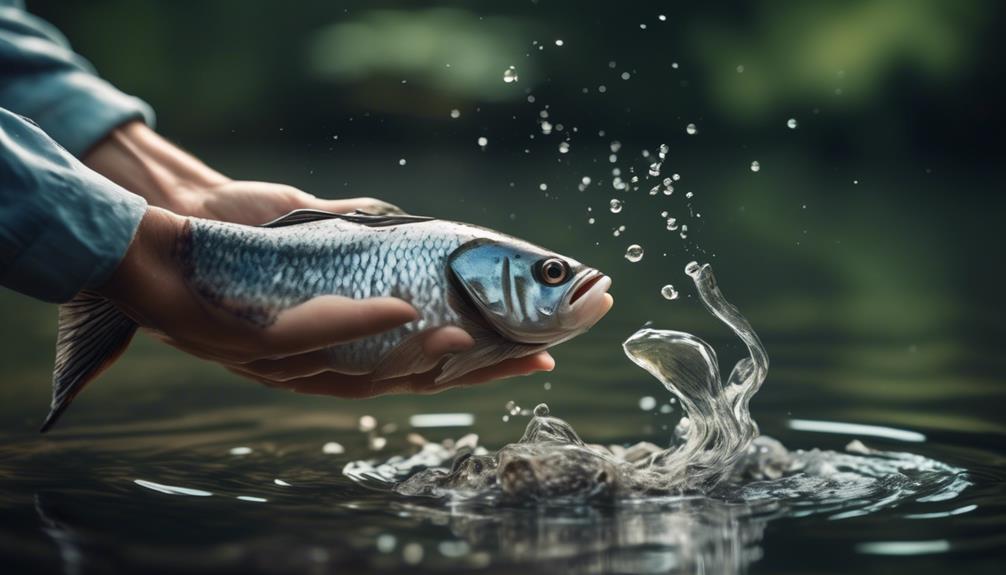Do you know that over 10 billion fish are caught by recreational anglers worldwide each year? This staggering number highlights the significant impact anglers have on fish populations and their ecosystems.
It's essential to consider the ethical implications of angling and the practice of catch and release. By doing so, you not only contribute to the conservation of fish populations but also minimize harm to individual fish.
Understanding the importance of ethical angling and catch and release will not only benefit the fish and their habitats but also enhance your overall angling experience.
Conservation of Fish Populations
To ensure the sustainability of fish populations, it's crucial for anglers to actively engage in conservation efforts through ethical angling practices and catch and release techniques. Fish population management is essential for maintaining sustainable fishing.
By practicing catch and release, you directly contribute to the ecological balance and the maintenance of biodiversity in aquatic ecosystems. When you release a fish back into the water, you're allowing it to continue its role in the food chain, which is vital for the overall health of the aquatic environment.
By responsibly managing fish populations, you help prevent overfishing and depletion of certain species. This, in turn, supports the ecological balance by ensuring that no single species dominates or diminishes, thereby maintaining the diversity of the ecosystem. Sustainable fishing, achieved through ethical angling practices, is crucial for the long-term health of fish populations. It allows fish to reach maturity and reproduce, which is a fundamental aspect of maintaining healthy population levels.
Furthermore, catch and release techniques aid in preserving genetic diversity within fish populations. When you release a fish, you're contributing to the preservation of its genetics within the ecosystem. This genetic diversity is crucial for the adaptation and survival of fish species in the face of environmental changes.
Therefore, your active engagement in conservation efforts through ethical angling practices and catch and release techniques significantly contributes to the overall health and sustainability of fish populations.
Minimizing Harm to Fish
By releasing fish responsibly, you actively contribute to minimizing harm and ensuring their well-being in the aquatic environment. Minimizing harm to fish is crucial in ethical angling and catch and release practices. Here are a few key actions you can take to minimize harm to fish:
- Reducing stress: When catching and releasing fish, it's essential to minimize the stress they experience. Avoid playing the fish to exhaustion. Reel them in as quickly as possible and use appropriate tackle to reduce fight times. This will help minimize the physiological stress the fish undergoes during the catch and release process.
- Proper handling: How you handle the fish can significantly impact their well-being. Always wet your hands before touching the fish to prevent damaging their protective mucous layer. Avoid squeezing them tightly or dropping them onto hard surfaces. If you need to handle the fish, do so gently and support their body properly to minimize any potential harm.
- Using barbless hooks: Barbless hooks can make the hook removal process much easier and less damaging for the fish. They cause minimal harm and reduce the stress and injury that barbed hooks can inflict during hook removal.
Sustainable Recreational Fishing
Sustainable recreational fishing requires anglers to consider the long-term impact of their activities on fish populations and the overall aquatic ecosystem. It's important to recognize that recreational fishing, when not practiced sustainably, can have significant environmental impacts. Overfishing and habitat destruction can lead to declines in fish populations and disrupt the balance of aquatic ecosystems. By adopting sustainable practices, anglers can help minimize these negative effects and ensure that future generations can continue to enjoy the recreational value of fishing.
One key aspect of sustainable recreational fishing is understanding the environmental impact of angling activities. This includes being mindful of catch limits, practicing proper catch and release techniques, and minimizing habitat disturbance. By adhering to catch limits, anglers can prevent overexploitation of fish populations and contribute to their long-term sustainability. Additionally, proper catch and release techniques, such as using barbless hooks and minimizing handling time, can improve the survival rates of released fish, reducing the overall impact on populations. Minimizing habitat disturbance, such as avoiding sensitive spawning areas, also plays a crucial role in maintaining the health of aquatic ecosystems.
Furthermore, sustainable recreational fishing not only helps conserve fish populations and their habitats but also preserves the recreational value of fishing. By ensuring that fish populations remain abundant, anglers can continue to enjoy the thrill of catching fish and the overall experience of being out on the water. Additionally, sustainable practices contribute to the overall health and resilience of aquatic ecosystems, benefiting not only anglers but also the broader community. Therefore, by considering the long-term consequences of their actions, anglers can play a vital role in sustaining the enjoyment of recreational fishing for years to come.
Ethical Treatment of Wildlife
When engaging in recreational fishing, it's crucial to consider the ethical treatment of wildlife to ensure their well-being and conservation. By practicing ethical treatment of wildlife, you contribute to the overall welfare of the ecosystem and help maintain a sustainable environment for future generations.
Here are some key aspects to consider for ethical practices:
- Proper Handling: Always handle fish and other wildlife with care and respect. Minimize the time they spend out of the water and handle them gently to minimize stress and potential injury.
- Use of Barbed Hooks: Consider using barbless hooks to minimize damage to the fish and facilitate easier hook removal. This reduces the risk of injury and improves the chances of survival for the released fish.
- Responsible Disposal of Waste: Dispose of fishing lines, hooks, and other waste properly. Wildlife can become entangled in discarded lines, leading to severe injury or death. Proper disposal helps safeguard the well-being of wildlife in and around the fishing area.
Preserving Aquatic Ecosystems
To ensure the well-being and preservation of aquatic ecosystems, it's essential to understand the impact of recreational fishing on the environment and take proactive measures to minimize any detrimental effects. Biodiversity protection is crucial for the health of aquatic ecosystems. When anglers practice catch and release, they contribute to maintaining the balance of species within the ecosystem. By releasing fish back into their natural habitats, anglers help ensure that various species can continue to thrive, thus preserving biodiversity.
Habitat preservation is another key aspect of maintaining the health of aquatic ecosystems. Recreational fishing, if not conducted ethically, can disturb the natural habitats of aquatic species. By promoting ethical angling practices and catch and release, anglers can minimize the disruption to these habitats, allowing them to remain intact and supportive of the diverse aquatic life they sustain.
Water quality maintenance is also impacted by recreational fishing activities. Proper catch and release techniques ensure that fish aren't needlessly harmed, preventing the release of harmful substances into the water. Additionally, promoting ethical angling practices encourages a greater sense of environmental stewardship, leading to a more widespread understanding of the importance of maintaining high water quality standards.
Responsible Angler Behavior
Ensure that your fishing activities are conducted in a responsible manner to minimize negative impacts on the aquatic environment and its inhabitants. As an angler, you have a direct influence on the welfare of fish and the overall health of aquatic ecosystems. By practicing environmental stewardship and embracing angler responsibility, you can significantly contribute to the conservation of marine life and habitats.
- Fish Welfare: Handle fish with care to minimize stress and injury. Use barbless hooks for easier and less damaging hook removal. Support the fish in the water until it can swim away on its own to ensure its full recovery.
- Angler Impact: Be mindful of your surroundings and the potential impacts of your presence. Minimize disturbance to nesting sites and avoid trampling on sensitive vegetation. Properly dispose of any waste and never leave behind any fishing gear.
- Environmental Stewardship: Respect catch limits and size regulations to maintain healthy fish populations. Use non-toxic fishing gear to prevent water pollution. Participate in local conservation efforts and educate others about responsible angling practices.
Benefits of Catch and Release
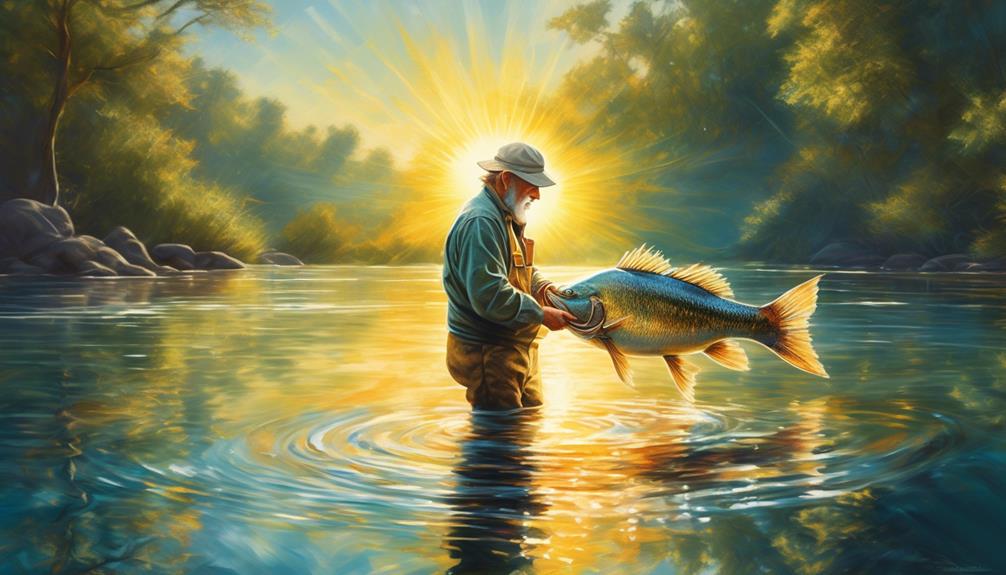
As a responsible angler, you directly impact the welfare of fish and the health of aquatic ecosystems. One valuable practice in promoting their conservation is the strategic use of catch and release techniques.
The benefits of catch and release are significant, with one of the most important being the minimization of stress on fish populations. When fish are caught and released properly, it reduces the duration of air exposure and handling, which in turn minimizes stress and increases their chances of survival after release. By implementing catch and release, you contribute to the preservation and sustainability of fish populations, ultimately maintaining a balanced ecosystem.
Furthermore, catch and release helps to minimize the environmental impact of angling. Releasing fish back into the water prevents overfishing and aids in maintaining the natural balance of aquatic habitats. It also contributes to the conservation of species and supports biodiversity.
Through this practice, you actively participate in the preservation of the natural environment, ensuring that future generations of anglers can continue to enjoy the sport.
Promoting Ethical Angling Practices
By practicing ethical angling, you actively contribute to the preservation of fish populations and the sustainability of aquatic ecosystems. It's important to promote ethical angling practices to ensure fish welfare and sustainable fishing for future generations.
Here's how you can actively promote ethical angling:
- Fish Welfare: Prioritize the well-being of fish by using proper handling techniques, minimizing their time out of water, and using barbless hooks to reduce injury and stress. By treating fish with care and respect, you can help ensure their survival after being released back into the water.
- Sustainable Fishing: Educate yourself and others about sustainable fishing practices, such as adhering to catch limits, respecting protected species, and using proper gear to minimize harm to the environment. By understanding the impact of your angling activities, you can help maintain the balance of aquatic ecosystems.
- Angler Education: Share your knowledge of ethical practices with fellow anglers, especially newcomers to the sport. By spreading awareness and setting a positive example, you can inspire others to prioritize ethical angling, ultimately leading to a collective effort in preserving fish populations and their habitats.
Frequently Asked Questions
Does Catch and Release Fishing Actually Benefit Fish Populations in the Long Term?
Catch and release fishing does benefit fish populations in the long term. The impact of conservation efforts is evident in increased survival rates and improved population dynamics.
Fish behavior, environmental factors, and angling techniques all play a role in catch and release effectiveness.
Ethical considerations and sustainability practices are crucial for maintaining healthy fish populations.
What Are Some Alternative Methods for Ethical Angling That Don't Involve Catch and Release?
If you're looking for alternative methods for ethical angling that don't involve catch and release, consider sustainable harvesting and live release.
Another option is selective harvesting, using barbless hooks to minimize harm to the fish. These approaches prioritize the well-being of the fish population while still allowing for the enjoyment of angling.
Sustainable harvesting ensures that fish populations remain healthy, while live release and selective harvesting help minimize negative impacts on the ecosystem.
How Can Anglers Ensure That They Are Using the Most Humane and Ethical Fishing Equipment?
To ensure you're using the most humane and ethical fishing equipment, start by choosing eco-friendly gear and following ethical fishing practices. Opt for barbless hooks to minimize harm to fish and use non-toxic, biodegradable bait to protect the environment.
Properly handle and release fish using wet hands and avoid over-stressing them. Selecting gear made from sustainable materials and supporting companies with ethical fishing practices also contributes to responsible angling.
Are There Any Specific Regulations or Guidelines for Ethical Angling and Catch and Release in Different Regions?
In different regions, regulations and guidelines for ethical angling and catch and release vary. Enforcement of these rules is crucial for conservation and sustainability of fish populations.
It's important to be aware of the specific regulations and guidelines in your area to ensure ethical angling practices. Following these rules not only promotes responsible fishing but also helps in maintaining the balance of aquatic ecosystems.
What Are the Potential Drawbacks or Limitations of Catch and Release Practices?
When considering catch and release practices, it's important to acknowledge potential drawbacks and limitations. While it can reduce fish mortality, there's still a risk of injury or stress. This could impact the ecosystem and fish populations.
However, with proper handling and humane practices, these limitations can be minimized. By promoting sustainable fishing practices and conservation efforts, catch and release remains an important tool for protecting fish stocks and maintaining healthy ecosystems.
Conclusion
So, next time you head out for a day of fishing, remember the importance of ethical angling and catch and release.
By practicing these principles, you can help conserve fish populations, minimize harm to fish, and preserve aquatic ecosystems. Plus, you'll be promoting sustainable recreational fishing and ethical treatment of wildlife.
So, keep up the responsible angler behavior and enjoy the benefits of catch and release for the future of fishing.
Happy angling!
